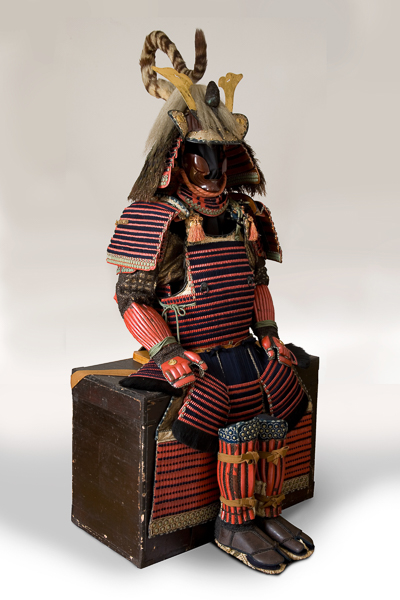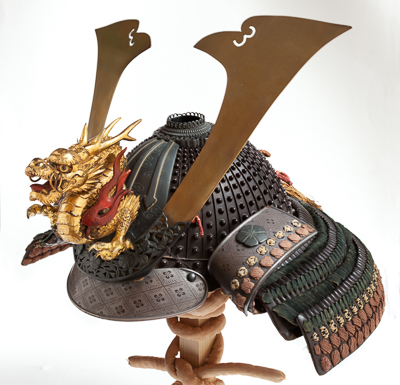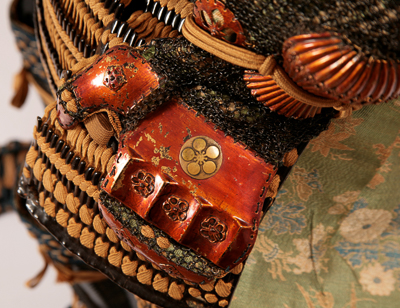Original Samurai Armours: All You Need to Know.

When were samurai armors produced?
The Japanese armor, as we know it, was born between the 10th and the 11th Century as an evolution of more ancient prototypes made up of large metal plates. However, it is only between the 12th and the 15th Century that it accomplished its evolution. At the beginning of this period – that we could refer to as “Middle Ages” – samurai still fought on horseback, and bows were their main weapons. The armors of this period were called ô-yoroi (literally “big armor”) and were conceived to fight battles between cavalries. The helm (kabuto) was hemispherical and composed of riveted plates; it included a neck protection (shikoro) whose upper plate, a very large one, extended forward before folding up behind as a safeguard for the face against arrows (fukigaeshi). The cuirass consisted of a one piece with tiny iron plates tied end to end, so that it could be both robust and flexible enough.
What material were samurai armors made of?
The structure of the original samurai armors, unbelievably, has not changed much over the centuries. The traditional construction required hundreds of tiny iron or leather plates (kozane) to be knotted together with silk or hide strips. Such construction was later simplified by using larger, riveted plates or silk-tied plates as for the ancient armors. Iron was often covered in lacquer to avoid rust, and this usage remained unchanged for six hundred years. Bamboo, contrary to what is widely written, was never used for the original samurai armors since it was reserved for training armors.
Where were samurai armors produced?
Feudal Japan was divided into regions governed by daimyō. Depending on the prestige and the wealth of each daimyō, there could have been a specific gunsmith school in his fief. Hence, some typologies of samurai armors are immediately recognizable as unique to certain areas, though most of the ones from the Edo period were constructed by independent workshops that would sell their products in the capital city, where they were purchased by samurai from all over Japan.
Why armors have been produced for so long in Japan?
In Europe, with the introduction of firearms, soldiers’ fighting skills became less and less essential. Vice versa, mobility became a strategic element of the military science and, from the 17th Century, when firearms became effective even against the best armors, the latter became an unnecessary expense. It should be noted, though, that generals and royal line commanders used to wear complete armors until the second decade of the 18th Century. In fact, it was the most practical way to observe the battlefield on horseback and, at the same time, to be protected from the foes’ muskets.
Firearms were introduced in Japan in 1543, when the first Portuguese ship made landfall on Tanegashima Island. It is the beginning of a new era for Japanese armors. Soon enough, there was a call for more practical, easier-to-produce and fix armors, whose plates needed to be particularly robust, but not too heavy. They refined what is commonly known as “modern armor” (tosei gusoku); changes were radical and involved each and every element of the gear. Kabuto became more tough and hefty in order to withstand blows from the harquebus, whereas fukigaeshi lost their defensive function to become smaller and purely ornamental. The cuirass (dô) was now fabricated with large-scale plates simply tied up together, or even riveted, but always divided into two or more hinged sections so that it could be worn quickly. As it happened for fukigaeshi, sode too became smaller – or disappeared –, while light protections for the face (mengu), the arms (kote) and the legs (haidate) were added. The advantages of this new armor were various: not only it was more robust and cheaper to build, but it was also easier to wear in a fight, and, in case it rained, laces did not become heavy from the absorbed water.
So why in Japan samurai armors were not abandoned as it happened in Europe? Because, at the beginning of the Edo period in 1615, all firearms were banned in Japan, therefore there was no additional improvement of the techniques that made Japanese armors useless any longer. Furthermore, Japan had isolated itself and lived in peace for three centuries, hence tosei gusoku, conceived to respond to a civil war, remained all the rage even after Japan’s unification, and for the following peaceful period. In fact, if it is understandable that armors, at first, were produced because armies needed to remain active to prevent riots and treasons, it is nevertheless critical to understand that armors had a fundamental role also later, that is to say as samurai’s official uniform, used and exhibited on important occasions.

Were samurai armors used in combats?
Most samurai armors that we see around date back to the Edo period (1615-1867) and were never used in combats, since the last conflict fought in samurai Japan was the Sekigahara Battle, in 1600.
Nonetheless, among the impositions from the Shogunate during the Edo period, the most significant one was, without a doubt, the obliged residence in Edo, the so-called sankin kotai, a brilliant thinking aiming to deplete and, at the same time, control over the lords (daimyō). As a matter of fact, such imposition required all the daimyō to move periodically to Edo with expensive and sumptuous cortèges (daimyō gyoretsu), in order to furnish soldiers to the Shogunate, and to leave their families there as hostages. Accordingly, the alternate attendance between the capital and one’s fief, and the social need to lead a lavish life in Edo, placed financial strains on the daimyō for the benefit – among other things – of the production of dashing, sumptuous, extravagant samurai armors.
This relaxed climate of political stability led the armors to become an important status symbol, and no longer means of defence. For this reason, during the Edo period (1603-1867) the blacksmiths’ skills shifted towards the esthetical features, rather than towards the functional ones. Starting from the middle of the 18th Century, the splendour of the lacquers and the colourful ligatures, the use of golden chiselled hems and ornamentations all over the armor, and the constant research for unusual adornments became the very characteristics of the armors from this period. Some armorers specialised in repoussage techniques (uchidashi), producing dô, menpo and kabuto of an exquisite quality. In this period, ô-yoroi and dô-maru from the rich medieval style made a comeback: their large-scale sode and their complex ligatures highlighted the armorer’s ability, and some of the finest armors ever built were produced at this time.
In the 19th Century wars were a distant memory and, despite a tendency to imitate the ancient models with luxurious reconstructions that continued unabated, armorers of true talents began to disappear, the very ones who were first of all masters of metalworking, and who could produce helmets and masks that were works of art.
Do modern samurai armors exist?
In 1870, two years after the Meiji Restoration, Japan entered a new historic stage with the abolition of the feudal system. The samurai class no longer existed and, at the same time, the necessity to wear armors disappeared. Hence, it is not appropriate to speak of an “original samurai armor” if it was made after 1870, for the simple reason that its natural intended use could not be attiring samurais, but rather adorning the house of European or American tourists.
How to recognise the original ancient samurai armors?
We need certainly some experience to recognise original samurai armors, but luckily enough it is not so difficult. The techniques used by the artisans of the ancient Japan are indeed so refined and complex that nowadays very few people are capable of producing one; ironically, armors built nowadays with the same old techniques cost more than the original ancient ones! Samurai armors built as an imitation are always low quality and easily detectable, also because they are very similar one to each other.
A greater risk comes from composite armors, that is armors that look like the ancient originals, but that are de facto assembled with ancient elements from different armors. In such case, we need to be better-read to be able to understand if the styles of the various parts are congruent, even in the case of the same type of colour, silk and lacquer.

How to assemble a samurai armor
The traditional way to assemble an original samurai armor is on a wooden support leaned against the case the armor itself was preserved in. The use of anthropomorphic mannequins is, instead, typical of European collections from the end of the 19th Century, therefore it may be found in ancient collections such as the Stibbert Museum or the Chiossone Museum. Modern museums use often modern bases for the assembling, instead of the original armor cases.
Copyright © 2016 - giuseppe piva - VAT: 05104180962

